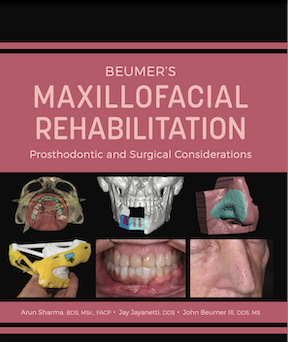Transcript of “Computer Guided Treatment Planning and Placement”
1. Dental Implants Computer guided treatment planning and implant placement John Beumer III DDS, MS Allesandro Pozzi DDS Robert Faulkner DDS Division of Advanced Prosthodontics, UCLA This program of instruc1on is protected by copyright ©. No por1on of this program of instruc1on may be reproduced, recorded or transferred by any means electronic, digital, photographic, mechanical etc., or by any informa1on storage or retrieval system, without prior permission.
2. Computer guided treatment planning and surgery
3. Computer guided planning and surgery • Computer guided treatment planning will be the standard of care within the next few years
4. Computer guided planning and surgery Defini1on – selec1on of implant sites and placement of dental implants employing surgical templates developed with CBCT scans and soCware programs.
5. Free hand drilling Previous method • Free hand drilling uses the template to iden1fy the posi1on of the implants. • The clinician decides the angula1on and depth of the osteotomy prepara1on.
6. Disadvantages of free hand implant placement Catastrophic mistakes made in posi1on and angula1on Labially inclined implants Buccally inclined implants Implants posi1oned interproximally Misaligned implants
7. Advantages of computer guided treatment planning and surgery • Visualize poten1al implant sites in 3D in rela1on to the proposed prosthesis • Precise implant placement • Less risk of compromising adjacent vital structures • Prefabrica1on of the prosthesis, abutments and immediate loading • Enables flapless surgery
8. Advantages Visualize poten1al implant sites in 3D in rela1on to the proposed prosthesis
9. Advantages Enables flapless surgery – Less postsurgical morbidity (pain, swelling etc.)
10. Advantages • BeSer implant distribu1on paSern for more favorable biomechanics
11. Advantages – Select an implant of proper Length and diameter
12. Advantages Precise implant placement Implants can be precisely placed in tooth posi1ons as opposed to interproximal posi1ons
13. Advantages Less risk of compromising adjacent vital structures – Inferior alveolar nerve – Branches of the lingual artery Courtesy Dr. N. Barakat
14. Advantages Less risk of compromising adjacent vital structures – Maxillary sinus – Anterior pala1ne foramen
15. Advantages Prefabrica1on of the abutments, prostheses
16. Two types – Fully guided surgery -‐ implies that the surgical templates with their drill sleeves (bushings) control the posi1on, angula1on, diameter as well as the depth of the implant osteotomy sites Computer guided implant placement
17. Indica1ons – Fully guided approach • Edentulous pa1ents Computer guided planning and surgery
18. Fully guided implant placement Provides more flexibility during placement of the implants-‐soC 1ssue manipula1ons, bone graCing etc. 2 Piece surgical template
19. 2 Piece surgical template Fully guided implant placement Used to Ensure the implants are perfectly parallel to one another Perform the desired alveoloplasty prior to implant placement
20. Fully guided approach • Used less frequently in par1ally edentulous pa1ents – Lack of mesial distal space – Lack of interocclusal space Computer guided planning and surgery
21. Fully guided approach • Used less frequently in par1ally edentulous pa1ents – Lack of mesial distal space – Lack of interocclusal space – Disadvantageous when bone or soC 1ssue graCing is necessary – Verifica1on and altera1on of apical coronal posi1on is difficult Computer guided planning and surgery
22. Disadvantages • Lack of flexibility during surgery – SoC 1ssue and bone graCing is more difficult – Coronal -‐ apical posi1on is difficult to visualize and control
23. Two types Semi-‐guided surgery -‐ employs the same treatment planning soCware programs as fully guided surgery, but the drill sleeves (bushings) incorporated within the surgical templates are designed to accommodate the 2-‐3 mm twist drills and as a result, control only the posi.on, and angula.on of the ini)al osteotomy. Computer guided implant placement
24. Indica1ons -‐ Semi-‐guided approach • Par1ally edentulous pa1ents – Posterior quadrants with limited interocclusal space • The esthe1c zone • Apical -‐ coronal posi1oning and angula1on is cri1cal • Permits bone and soC 1ssue graCing Computer guided planning and surgery
25. Semi-‐guided implant placement When soC 1ssue procedures or bone graCing are an1cipated during surgery – Pa1ents with thin periodontal biotype frequently require soC 1ssue supplementa1on and bone graCing
26. • When flexibility is required during surgery – The esthe1c zone • Apical – coronal posi1oning • GraCing Semi-‐guided implant placement
27. Combined fully guided and semi-‐ guided implant placement
28. Combined fully guided and semi-‐ guided implant placement • Posterior implants placed with fully guided approach • Anterior implants placed with a semi-‐guided approach
29. Combined fully guided and semi-‐ guided implant placement • The 1lted implants were placed using fully guided technique • The anterior implants were placed with a semi-‐guided technique
30. Fully guided or semi-‐ guided approach? • Interocclusal space • Mesial distal space • The need for bone or soC 1ssue graCing
31. Issues to consider Interocclusal space Limited mesial distal space Requires a minimum of 40 mm in the anterior region
32. v Visit ffofr.org for hundreds of addi1onal lectures on Complete Dentures, Fixed Prosthodon1cs, Implant Den1stry, Removable Par1al Dentures, Esthe1c Den1stry and Maxillofacial Prosthe1cs. v The lectures are free. v Our objec1ve is to create the best and most comprehensive online programs of instruc1on in Prosthodon1cs
33. v Visit ffofr.org for hundreds of addi1onal lectures on Complete Dentures, Implant Den1stry, Removable Par1al Dentures, Esthe1c Den1stry and Maxillofacial Prosthe1cs. v The lectures are free. v Our objec1ve is to create the best and most comprehensive online programs of instruc1on in Prosthodon1cs


